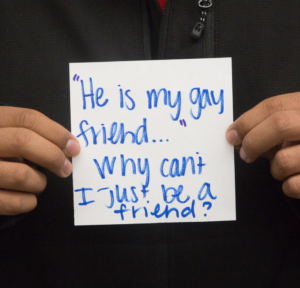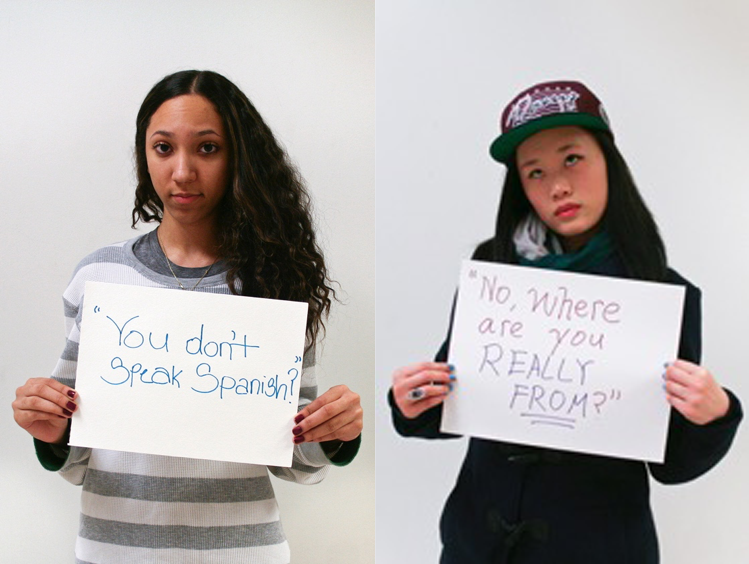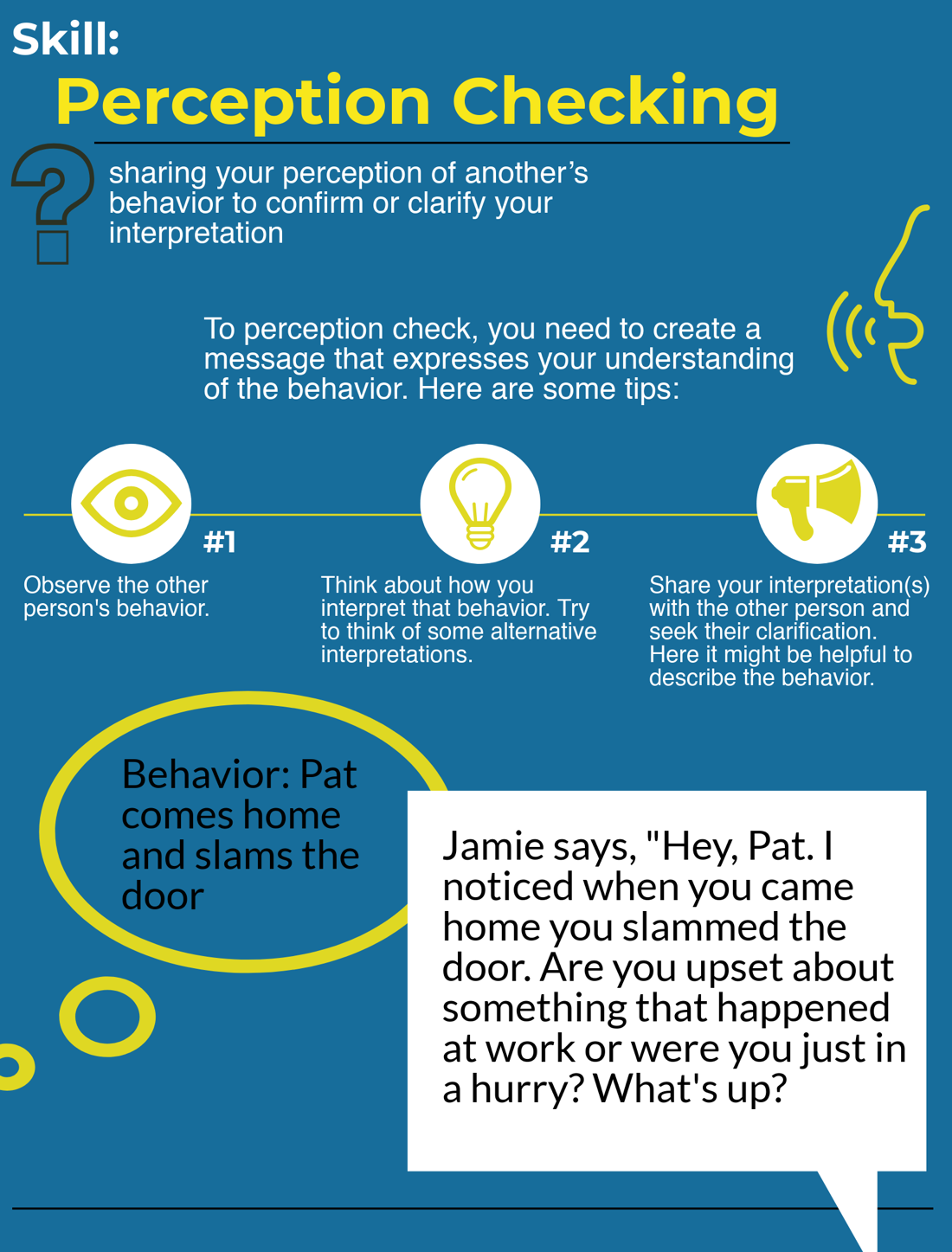In this section, we will cover the skill of perception checking, address contextual nuances that influence perception(s), and discuss the need for self-reflecting on our own perceptions.
3.4.1: Effective Communication: Perception Checking
The skill of perception checking is useful for managing our impressions. Perception checking is a strategy to help us monitor our reactions to and perceptions about people and communication. Perception Checking helps us slow down perception and communication processes and allows us to have more control over both. There are some internal and external strategies we can use to engage in perception checking. In terms of internal strategies, review the various influences on perception that we have learned about in this chapter and always be willing to ask yourself, “What is influencing the perceptions I am making right now?” Even being aware of what influences are acting on our perceptions makes us more aware of what is happening in the perception process. In terms of external strategies, we can use other people to help verify our perceptions. The cautionary adage “Things aren’t always as they appear” is useful when evaluating your own perceptions of another’s behavior.
You can also share your interpretation(s) of that behavior with the other person in order to check the accuracy of your perceptions. Perception checking involves being able to describe what is happening in a given situation, provide multiple interpretations of events or behaviors, and ask yourself and others questions for clarification. Some of this process happens inside our heads, and some happens through interaction.
Let’s take an interpersonal conflict as an example. Miguel and Edgardo are roommates. Miguel is in the living room playing a video game when they see Edgardo walk through the room with a suitcase and walk out the front door. Since Edgardo didn’t say or wave good-bye, Miguel has to make sense of this encounter, and perception checking can help with that. First, Miguel needs to try to describe (not evaluate yet) what just happened. This can be done by asking yourself, “What is going on?” In this case, Edgardo left without speaking or waving good-bye. Next, Miguel needs to think of some possible interpretations of what just happened. One interpretation could be that Edgardo is mad about something (at Miguel or someone else). Others could be that Edgardo was in a hurry and simply forgot or that they didn’t want to interrupt the video game. In this step of perception checking, it is good to be aware of the attributions you are making. You might try to determine if you are over attributing internal or external causes. Lastly, you will want to verify and clarify. So Miguel may want to call, text, or speak to Edgardo. During this step, it’s important to be aware of that the other person likely experienced the event differently than you. Even though Miguel has already been thinking about this incident, and is experiencing some conflict, Patrick may have no idea that their actions caused Miguel to worry. If Miguel texts and asks why Edgardo’s mad (which wouldn’t be a good idea because it’s expressed as an assumption) Edgardo may become defensive, which could escalate the conflict. Miguel could just describe the behavior (without judging Edgardo) and ask for clarification by saying, “When you left today you didn’t say bye or let me know where you were going. I just wanted to check to see if things are OK.”
The steps of perception checking as described in the previous scenario are as follows:
- Step 1: Describe the behavior or situation without evaluating or judging it (either internally or aloud).
- Step 2: Think of some possible interpretations of the behavior, being aware of attributions and other influences on the perception process.
- Step 3: Verify what happened and ask for clarification from the other person’s perspective. Also, be aware that the other person likely experienced the event differently than you.
3.4.2: Contextual Communication: Contextual Nuances that Influence Perception
Since all communication is contextual, we must be mindful of the role that context plays in our interpretations. As contextual factors change, so might our interpretations of a specific behavior. For example, the physical context (where the communicative interaction is physically taking place) could change the meaning we attribute to a behavior, such as fidgeting. If our partner was fidgeting while watching T.V. one night, we might interpret their behavior to mean they were nervous because they had something serious they want to discuss with us. However, if they were fidgeting at a party, we might think instead they were trying to avoid someone or feeling anxious about being around too many people.
The relational context (the relationship we have with another), will also influence our perceptions. If our supervisor speaks to us in short, clipped sentences then we may think they are having a bad day or in a hurry. But if our best friend were to do the same, we might instead think are mad at us. Cultural and individual frames, such as our personalities and previous experiences, also play a key role in our interpretations and perceptions. When communicating with others and decoding/interpreting their messages and behaviors, we need to be cognizant of not just the physical and relational contexts, but also of cultural and individual nuances.
3.4.3: Reflective Communication: Reflecting on Perceptions, Stereotypes, and Biases

Often times, we may not realize that the things that we say are actually microaggressions.
The final way to increase communication competence is to be self-reflective of our own perceptions. Specifically, it is important to reflect on how we perceive others and how these perceptions may be influenced by stereotypes and biases. Stereotypes are sets of beliefs that people have about a group of people, based on factors like race, ethnicity, gender, religion, age, ableness, physical appearance, speech, beliefs, etc. They serve to essentialize people based on group membership, rather than looking at individual and multiple facets of their identities. Stereotypes can make us biased and prejudiced towards a certain group, especially if we perceive them as being “not like us” or inferior in some way.
When it comes to stereotypes, it is important to note that they can be negative, positive or neutral. For example, Mexicans have historically been stereotyped negatively as “lazy” whereas some Asians have been stereotyped positively as “smart” or “good at math.” While negative stereotypes devalue and often render people who fall into a particular group inferior or deficient, even positive stereotypes can be harmful in that they objectify people and place unfair expectations on them. Moreover, stereotypes surrounding our co-cultural group memberships and identities, such as those related to gender, can lead to double standards. Think about all the double standards between women and men. The interpretations of a behavior, such as being sexually active, and the words used to describe it are typically negative for women, whereas the words used to describe sexually active men are positive. For example, a female who has had multiple sexual partners may be called a ‘slut,’ ‘thot’ or a ‘ho’ whereas a male may be called a ‘pimp,’ ‘player’ or ‘stud.’
Double Standards:
When it comes to terms used to describe sexually active women and men, there is a double standard. Terms used to describe women are usually negative, while those used to describe men are positive to neutral. Here are some definitions of common slang terms, according to dictionary.com (2019):
- “THOT (that-hoe-over-there): Slang: Disparaging and Offensive. a woman considered to be sexually provocative or promiscuous; a slut or whore.”
- “Slut: Disparaging and Offensive. a sexually promiscuous woman, or a woman who behaves or dresses in an overtly sexual way.”
- “Stud:a virile or sexually active man.”
Stereotypes can influence our interactions in both blatant and subtle ways, and often times we may not even realize our communication is influenced by stereotypes. We may even engage in a variety of unconscious macroaggressions in our everyday interactions without ever realizing it until they are pointed out to us. Microaggressions are verbal and nonverbal behaviors, intentional and unintentional, that communicate some sort of stereotype, bias, prejudice, and/or others another person based off of race, ethnicity, gender identity, sexual orientation, religion, ableness, and/or immigration status. For example, a woman walking down the street might unconsciously clutch her purse closer when she sees a large black man because of the prevalent stereotype of black males as ‘thugs.’ An Asian person may be complemented on their English or asked “Where are you really from?” (even if they were born in the U.S) reinforcing the stereotype that they are not ‘real’ Americans.

Microaggressions are verbal and nonverbal behaviors, intentional and unintentional, that communicate some sort of stereotype, bias, prejudice, and/or others another person based off of race, ethnicity, gender identity, sexual orientation, religion, ableness, and/or immigration status. The photos above were taken as part of a Racial Microaggressions photo series; you can view more on Kiyun Kim’s tumblr.
While we may not be aware that we are enacting microaggressions or think they are harmless behaviors and questions, they can take a serious psychological toll on the people who receive them. Consider how Graciella might feel after being admitted to Harvard, only to have a classmate exclaim “That’s great! Affirmative action really helped you- you’re so lucky that you get to benefit from it!”, rather than attributing Graciella’s acceptance to intelligence and hard work. While most people like to think they are fair-minded and judge everyone equally, we all hold stereotypes and biases. Even though it can make us feel uncomfortable, guilty, or even ashamed to reflect on our own biases and stereotypes, it important to examine how they creep into our communication and affect our interactions with others.
